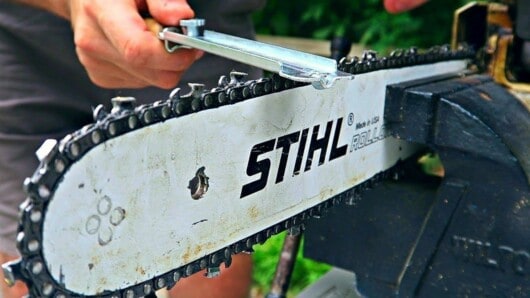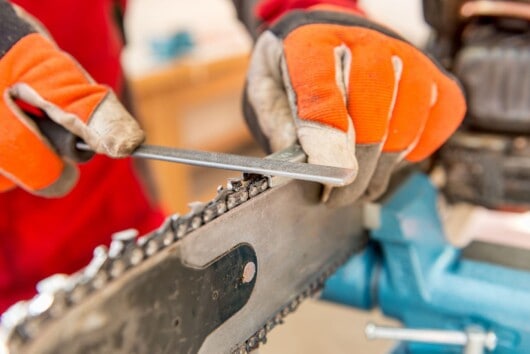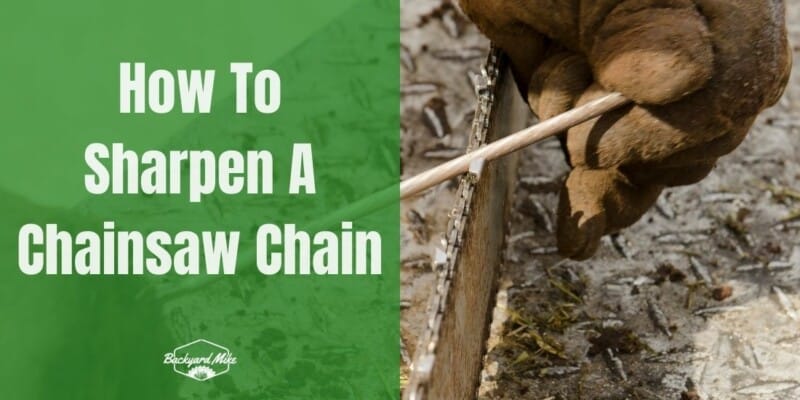Is a dull chainsaw chain affecting your chainsaw’s performance and ruining your cutting experience? It is common for chainsaws to become dull after a few cutting sessions. But it is easy to fix and shouldn’t be a cause of concern, and I will tell you why.
Sharpening a chainsaw chain is easier than you may think. There are two ways to sharpen a chainsaw chain. You can either do it using an electric chainsaw sharpener, or you can manually do it through a file. In this guide, you will get to know how to sharpen a chainsaw chain and a lot more.
Different ways to sharpen a chainsaw chain
As mentioned above, there are two simple approaches to sharpening a dull chainsaw chain. Firstly, the task can be easily handled by using an electric sharpener. If you regularly cut trees, then an electric sharpener will be an indispensable convenience. The other method you can go for would be to sharpen the chain manually using a sharpening file.

As electric sharpeners are used primarily by professionals, the sharpening file method should be preferred by DIYers. As the chainsaw chain primarily comprises several teeth, you’ll require a chainsaw file that will precisely match the size of an individual tooth of the chain.
Step 1: Arrange the right chainsaw file
Chainsaw files are created in specific sizes to match the size of the chainsaw teeth. If you go for a file that is too small or too large, then it’ll be difficult to sharpen the blade. While there are different sizes, the most popular ones are 4 millimeters, 4.8 millimeters, and 5.5 millimeters. Remember to check the instruction manual to be sure that you’re using the right-sized file.
4 mm file size
The 4 mm-sized files are paired with chainsaws having a chain pitch of 0.25 of an inch. The code number for referencing on the depth gauge is 1.
4.8 mm file size
The 4.8 mm-sized files are suitable for chain pitch of 0.325 of an inch. The code number for referencing on the depth gauge is 2.
5.5 mm file size
The 5.5 mm-sized files are suitable for chain pitch of 0.404 of an inch. The code number for referencing on the depth gauge is 4.
Step 2: Clean the chainsaw chain
Once you have arranged the sharpening file of the correct size, now comes the time to comply with the safety measures. Wear appropriate safety equipment like safety glasses, high-quality gloves, and a helmet when working with sharp objects. Begin working by cleaning the chain and removing any oil, dirt, and debris. Make use of a screwdriver and a waste towel for doing this. Depending upon the condition of your chainsaw chain, you might require mineral spirits. Inspect the chain teeth as you’re cleaning. If any of the chain teeth are damaged, the chain will be unsafe to work with. Instead of sharpening the chain, you should get it repaired or replaced first.
Step 3: Set the tension in the chain
The chain on the chainsaw will need to be set to the right tension for preventing problems when you use the chainsaw. Having a loose chainsaw chain will increase the probability of being on the end of chainsaw kickback.
Meanwhile, a chain that is too tight might not move at all. Moreover, a tight chain will increase the friction between the parts and result in excess heat building up. Overheating will increase the risk of fire while significantly reducing the part’s lifespan.
For avoiding this issue, check the chainsaw tension by locating and adjusting the tension screw or the side/front of the saw. Then, simply turn the screw clockwise for increasing the tension or counterclockwise for loosening the tension. Test the chain by slightly pinching from the underside of the guide bar so that it pulls away. Release the chain, and it must snap into position, indicating that the chain is tight enough to be used. If you’re unable to pull the chain, it is too tight and should be loosened. In case the chain doesn’t snap into position, it is loose and must be tightened.
Step 4: Stabilize your chainsaw
For getting the best results, you’ll need to stabilize the chainsaw before beginning to file the chain. Some people prefer to place the chainsaw in a vise. They use the clamps to hold the guide bar in a way the chain can freely rotate. Alternatively, you could even enlist a helper to keep the tool steady when you’re working.
Step 5: Start sharpening at the shortest cutter
Look for the shortest cutter blade on the chain. This is where you must start with the sharpening method. If all the cutters are of the same height, then start with any tooth on the chain. However, make sure that you mark with a pencil or marker the first tooth that you sharpen. This way, you’ll be able to continue working in the same chainsaw chain direction.
Step 6: Stroke/file the teeth at an angle
Set the sharpening file into the notched section. Hold the file at a certain angle, the same angle at which the teeth were initially/most recently filed. Simply slide the file across the tooth, twist it slightly to create friction as you’re filing. From the initial cut, proceed to file all the teeth around the chain.

Step 7: File the other side of the chain
Reverse the saw and continue filing each of the cutters that you didn’t initially file. Once you’ve finished, the flat tops of the cutters should be almost precisely the same length.
Step 8: Check for the depth gauges
Lastly, inspect the depth gauges (the curved links in between the cutters). Each depth gauge needs to be shorter than the adjacent cutter. In case you find a depth gauge with a height exceeding its closest cutter, you should file down the raker such that it sits around 1/10th of an inch below the height of the cutter counterpart.
How to sharpen a chainsaw chain with an electric sharpener
If you’re working with an electric chainsaw sharpener, you’ll need to measure the pitch and gauge of the chain. This will help you determine the appropriate sharpening stone to use with the chainsaw and the correct tooth angle.
Place your chainsaw chain on the sharpener and properly tightening the vise to hold the chainsaw chain in place. Once you’ve got all the angles set according to the grinding angles chart (usually included with an electric chainsaw sharpener). You will be able to lower the grinding wheel to the chain for sharpening the current cutting tooth. Loosen the vise and slide the chain for lining up the next cutting tooth. Then, tighten the vise and start sharpening the tooth using the grinding wheel.
- You must measure the chainsaw chain and refer to the instruction manual for the correct sharpening setup
- Ensure that you set the wheel depth to stop, preventing the grinding wheel from coming into contact with the chain chassis
- Complete the right-hand teeth in sequence, then the left-hand cutting teeth in sequence to avoid switching back and forth
Keep the chainsaw chain sharp for proper maintenance
A chainsaw has a wide range of uses, including cutting firewood, cutting branches, maintaining your backyard, and more. Different chainsaws tend to operate in different ways and have different maintenance needs. You must study the instruction manual that comes with your chainsaw for understanding the needs of your specific model.
If your chainsaw chain is sharp, it’ll be easier and safer to use the tool. It will minimize the wear and tear of the chainsaw while also improving overall efficiency. There are a few telltale signs that you should know about if a chainsaw chain has to be sharpened. Take immediate action and grab an electric sharpener or sharpening file if you notice any of these signs.
- Pay close attention to the chainsaw debris. In case your chainsaw is spitting out dust instead of wood chips, it’ll likely require sharpening.
- If you find that you need to put a lot more physical effort into cutting through wood, it is a sign that the teeth on the chainsaw are dull.
- Another sign that your chainsaw chain needs sharpening is if the bland pulls to one side more than the other. Sharpen the chainsaw chain and even up the cutting teeth.
It is important to maintain other parts of your chainsaw too, as it’ll improve the performance and increase its lifespan. The chainsaw parts will benefit from lubrication with a bar and chain oil. You can pour lubricant into your chainsaw’s oil reservoir where oil is gradually dispersed to keep the chainsaw running smoothly.
- Occasionally inspect the motor and add lubrication when needed.
- Regularly check if there is a sufficient amount of oil in the reservoir.
- Check the guide bar, which is used for holding the chain in place. It might get twisted or bent during use.
- Avoid any problems by ensuring the guide bar is in proper condition before starting the chainsaw every time. Even when you’re working, it is wise to spot-check this crucial part.
Conclusion
Hopefully, this guide would have given you more than enough information about the significance of a sharp chainsaw chain. It is common to have a dull chainsaw chain, especially after a few uses. You can simply use any of the two methods mentioned above. Although, the sharpened file will be the simpler option as the electric sharpener is for professional use. The guide will help you through all the steps that you need to take to easily sharpen the chainsaw chain.


